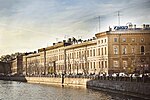Rimsky-Korsakov Monument
Monuments and memorials in Saint PetersburgMonuments to composersOutdoor sculptures in RussiaStatues in Russia

The Rimsky-Korsakov monument is a bronze statue of Nikolai Rimsky-Korsakov (1844-1908), the Russian composer, teacher, conductor, public figure, music critic, and member of the "Mighty Handful".The monument was erected in 1952 in Saint Petersburg (then known as Leningrad) in Theater Square in front of the N. A. Rimsky-Korsakov Saint Petersburg State Conservatory. Rimsky-Korsakov taught there for almost forty years. The monument was created by sculptors V. Bogolyubov and V. Ingal, and architect M. Shepilevsky. The statue has been listed as a cultural monument.
Excerpt from the Wikipedia article Rimsky-Korsakov Monument (License: CC BY-SA 3.0, Authors, Images).Rimsky-Korsakov Monument
Театральная площадь, Saint Petersburg
Geographical coordinates (GPS) Address External links Nearby Places Show on map
Geographical coordinates (GPS)
| Latitude | Longitude |
|---|---|
| N 59.92647 ° | E 30.29722 ° |
Address
Н. А. Римский-Корсаков
Театральная площадь
190999 Saint Petersburg (Адмиралтейский округ)
Saint Petersburg, Russia
Open on Google Maps









